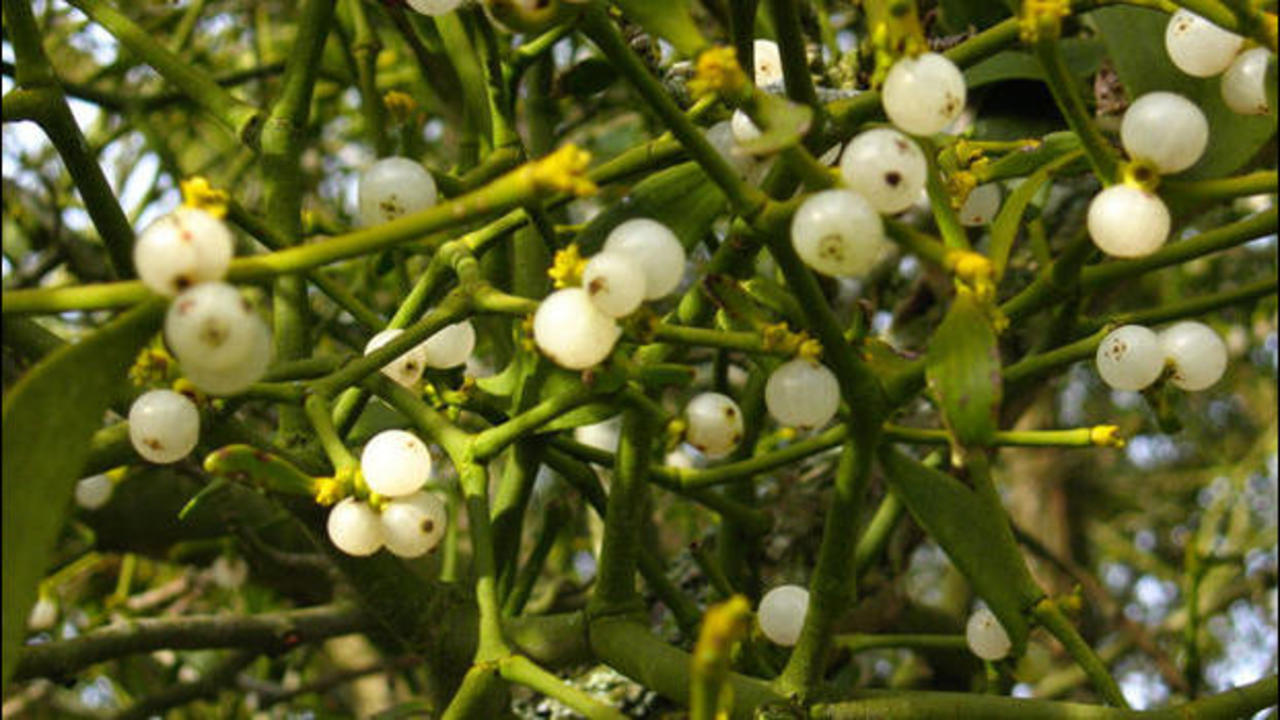The iconic image of mistletoe adorns doorways and festive decorations this holiday season. In Texas, this plant is more than just a symbol of holiday cheer; it plays a unique — and parasitic role in our local ecosystem. Let’s explore its Christmas lore, ecological impact, and some useful tips and tricks to enjoy the fun of mistletoe and avoid the negative sides of this beauty.
Mistletoe in Texas
In the heart of Texas, the American mistletoe (Phoradendron leucarpum) is a common sight, yet often misunderstood. Contrary to the festive red-berried portrayal in holiday movies, true mistletoe is distinguished by its small white berries. These are frequently confused with holly, which sports the iconic red berries.
Mistletoe grows actively during spring and summer, developing new shoots and leaves. Its small white berries, a hallmark of the plant, are produced in late fall and winter, making it more visible against the bare branches of deciduous trees during these colder months. This perennial plant’s growth cycle aligns with the changing seasons, with seed dispersal and germination typically beginning in spring.
More Than Just a Kiss Catalyst
When you notice these green, leafy clumps of white berries nestled in your trees, it’s a sign that the mistletoe, a hemiparasitic plant, is tapping into your tree for survival. This isn’t just a harmless holiday guest; it’s a plant that could be sapping the life from your trees.
Mistletoe secures its hold on a tree through a sticky seed, typically transported by birds or mammals. Once it takes root, it develops a system that burrows into the tree’s bark. This allows the mistletoe to draw vital water and nutrients from the tree while still performing photosynthesis in its leaves.
Various tree species fall victim to mistletoe’s embrace in the Texan landscape. Mesquite, oaks, sugarberries, elms, and several pine species in West Texas are among its common hosts. The impact of mistletoe on these trees is more than cosmetic; it’s a real threat. Although a mistletoe infestation is unlikely to kill a tree outright, it can lead to the death of branches, compromising the tree’s health and appearance. As such, It may be wise to address mistletoe infestations in your trees proactively, particularly high value trees near human use areas.
More threats to Texas Trees: Live Oak Recovery After Texas Winter Storms
Mistletoe Mitigation
Pruning is the most common and effective method to manage mistletoe and mitigate its impact. When you spot mistletoe in its early stages, typically within two to three years of growth, removing the visible parts of the plant can prevent it from maturing and spreading seeds. This proactive approach helps control the spread of mistletoe and preserves the tree’s health.
In cases where mistletoe has extensively spread or if the tree’s health is severely compromised, it’s advisable to consult a certified arborist. An arborist can assess the situation accurately and recommend the best action. For those looking to find a certified arborist in their area, a visit to a professional arborist directory or local horticultural society’s website can be a helpful starting point.
Mistletoe: A Deer’s Delight in the Texan Landscape
While it harms your trees, it’s a coveted treat for deer, especially when adorned with fresh berries. This plant becomes a significant part of their diet, particularly in areas where it’s abundant and other food sources are limited.
Nutritionally, mistletoe presents an interesting profile for deer. It’s low in protein but moderately high in fiber and rich in minerals, making it a beneficial supplement to their regular diet. Research suggests that barring any negative health impacts, mistletoe could be a viable dietary component for ruminants like deer. In areas with high deer densities, it’s not uncommon to see no mistletoe growing from the ground level up to around four feet. It’s not that mistletoe won’t grow low to the ground; it’s just that deer like to eat it that much.
But beware, while deer may relish mistletoe, it’s hazardous for human consumption, containing toxic compounds.
While mistletoe adorns our festive celebrations with its unique charm, it’s important to recognize its complex role in Texas’ ecosystem — from being a parasitic challenge for trees to a cherished dietary component for deer. Understanding and managing this dual nature of mistletoe ensures we can safely enjoy its beauty and benefits during the holiday season and beyond.









